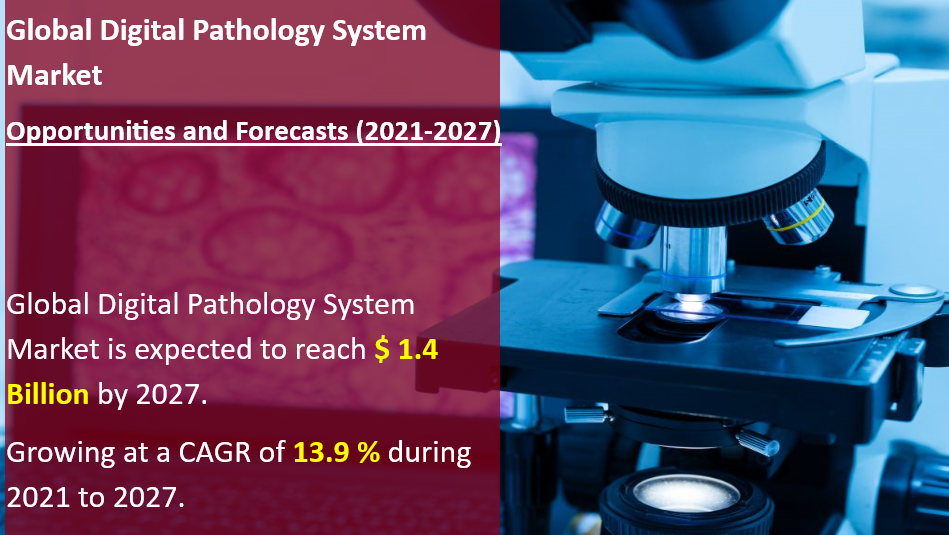Report Overview
The report provides market estimates for base year 2020 and a yearly forecast to 2027 in terms of revenue (USD Billion) unless stated otherwise. Market for each segment has been provided on a global and regional for the above-mentioned forecast period.
Digital pathology is as an image-based information setting enabled by computer technology that allows management of information generated through a digital slide. Digitalization of pathology has led to the automation of tests during disease diagnosis among other applications. For instance, a single digital instrument can perform tests that were previously carried out using five instruments by pathologists. Digital pathology solutions offer scrutiny & analysis of images on a computer, high-resolution sample scanning, and online storage of digital slides, which enable pathologists to cross-examine slides without physical evidences.
COVID-19 Impacts
COVID-19 is a new strain of corona-virus that has not been previously identified in humans. Corona-viruses (CoV) are a family of RNA (ribonucleic acid) viruses. COVID-19 started in Asia and is now spreading over the rest of the world via person-to-person contact and community spread. COVID-19 pandemic may have a potential impact on Global Market.

Report Includes
- The report provides information about the current and upcoming trends in the market from 2021 to 2027, which helps determine the prevailing opportunities.
- The report includes information related to key drivers, restraints, and opportunities with a detailed impact analysis.
- The study provides an in-depth analysis of the market with current trends and future estimations to elucidate the imminent investment pockets.
- 55 Market data Tables and 45 Figures.
- Patent analysis covering significant patent allotments
- Information on key market participants, extensive product segments, supporting technologies, trends and market dynamics, competitive intelligence, and geographic trends.
- Profiles of key companies, product portfolios, strategies and recent developments, including 3DHISTECH, Huron Technologies International Inc., Mikroscan Technologies Inc., Nikon Instruments Inc., Visiopharm and Ventana Medical Systems Inc.
- Up-to-date analyses of competitive developments, such as expansions, joint ventures, new products launches, expansions, and mergers & acquisitions in the global personal protective equipment market.
- The digital pathology market size and estimations are based on a comprehensive analysis of key developments in the digital pathology industry.
- A qualitative analysis based on innovative products facilitates strategic business planning.
- The development strategies adopted by the key market players are enlisted to understand the competitive scenario of the market
- Comprehensive analysis of factors that drive and restrict the growth of the market is provided.
Scope of the reports
- The global market is witnessing a huge influx of companies, which is why it is expected to grow manifold from the existing 40 companies. The scope of this report includes the analysis of various regions, namely, North America, Europe, Asia-Pacific, and LAMEA.
- Digital pathology market is currently booming owing to rise in research and development activities. Surge in incidence and prevalence of chronic diseases and demand for advanced therapeutics are leading to increase in demand for new drugs and medicines. This in turn is increase in focus of research and development.
- Some of the key factors such as efficient cost of digital pathology products, ease of virtual transportation of slides, and high efficiency of digital pathology systems are the major factors that boost the growth of the global digital pathology market. In addition, growth in adoption of digital pathology as compared to conventional pathology diagnosis drives the market growth.
- Digital pathology is expected to witness significant growth in the near future, owing to increase in adoption of digital pathology over the traditional methods. In addition, the market is exhibiting high growth rate due to increase in usage of digital scanners. Moreover, surge in advantages offered by digital pathology and rise in prevalence of chronic & infectious diseases significantly contribute toward the growth of the market.
- Rapid technological advancements in digital pathology systems are expected to contribute to market growth. Advancements such as digital imaging, computerization, robotic light microscopy, and multiple fiber optic communications are also contributing to the growth. Whole slide imaging is one such technique that has various advantages over conventional light microscopes, which is expected to provide this market with lucrative opportunities in the forthcoming years.
- It also explains the major drivers and current trends within the particular sector.
Trend and Development
- In February 2019, Neuberg Diagnostics and OptraSCAN Inc. announced the launch of Global TELEPath Network for the pathologist community in UAE, India and South Africa under a new joint venture namely Neuberg DIGIPATH. This is enabled to increase focus on providing advanced and affordable digital pathology solutions
- The other key participants are Royal Philips and In June 2018, a Dutch conglomerate, Royal Philips, acquired the Irish PathXL, one of the largest pathology image-based analysis firms. This acquisition was carried out to develop integrated tools targeting applications in computational biology, workflow solutions, education, and image analytics.
- North America dominates the global digital pathology market in 2018 and the trend is anticipated to continue during the forecast period. Well established healthcare infrastructure, early adoption of advanced solutions and vast patient pool are the factors anticipated to drive the global digital pathology market in the region.
- Asia Pacific is likely to be a highly lucrative region for the digital pathology market and is expected to expand at a high CAGR during the forecast period. Demand for newer solutions, surge in geriatric population with various chronic diseases and growing government initiatives to improve healthcare infrastructure are key factors likely to boost the digital pathology market in Asia Pacific.
- Cancer is emerging as crucial public health problem worldwide and it is unconquered. World Health Organization states that, in 2018, estimated 9.6 million deaths and 1 million new cases of cancer were recorded globally
Segments covered in the reports
| Attribute | Details |
|---|---|
| Market size available for years | 2014–2027 |
| Base year considered | 2020 |
| Forecast period | 2021–2027 |
| Historical period | 2014-2019 |
| Forecast units | Value (USD) & Volume (Million Units) |
| Segmentation | By Regions North America, Europe, Asia Pacific, Latin America and Middle East & Africa |
| By Countries United States, Russia, China, Germany, United Kingdom, France, Japan, Israel, Saudi Arabia, South Korea, United Arab Emirates, Canada, Indonesia, Malaysia, Switzerland, Australia, India, Italy, Sweden, Spain, Belgium, Netherlands, Norway, Brazil, Argentina, Mexico, South Africa and 54 Others. |
|
| By Application Teleconsultation, Disease Diagnosis (Cancer Cell Detection and Others), Drug Discovery and development and Training & Education. |
|
| By Product Scanners, Software and Storage & Communication Systems. |
|
| By End User Educational, Clinical, Pharma & Biotech Companies and Others |
|
| Companies covered | Biosystems, Hamamatsu Photonics, Omynx LLC, 3DHistech, Inc., Olympus Corporation, GE Healthcare, Ventana Medical Systems, Inc., Objective Pathology Services, Mikroscan Technologies, Inc., Koninklijke Philips, N.V, F. Hoffmann-La Roche Ltd, Inc., Sectra AB, Inspirata, Huron Technologies, Nikon Corporation, Visiopharm and others. |

Report coverage
- Recent Trend and Developments: The major players operating in the global market have adopted key strategies such as product launch and acquisition to strengthen their market outreach and sustain the stiff competition in the market.
- Key Market Players: Key players list and Key companies profiled in this market include.
- Revenue forecast, company share, competitive landscape and growth factors.
Objectives of the study
To provide detailed information regarding drivers, restraints, opportunities and challenges are influencing the growth in the respective market. To analyze the competitive intelligence of players based on company profiles and their key growth strategies. To strategically analyze micro markets with respect to the individual growth trends, their prospects, and their contribution to the total respective market. To analyze competitive developments such as expansions, and product launches, along with research & development (R&D) activities undertaken in the respective market. A unique model is created customized for each study also offers suggestions that help enterprises to identify and mitigate risks.
Note –
- GIR Reports will also support you post-purchase for a period of 6 months to answer any of your queries related to the following market and to provide you any more data if you need, for your analysis.
- Also, you can buy some selected Chapters from the report.
FREQUENTLY ASKED QUESTIONS?
- What is the total market value?
- What will be the growth in 2027?
- What are the key trends in the market?
- What are the major players in the markets?
- What are the key growth strategies of industry players?
- Which region would offer a higher growth?
- What are the countries included in the rest of the word segments?
- How can I get report sample?








